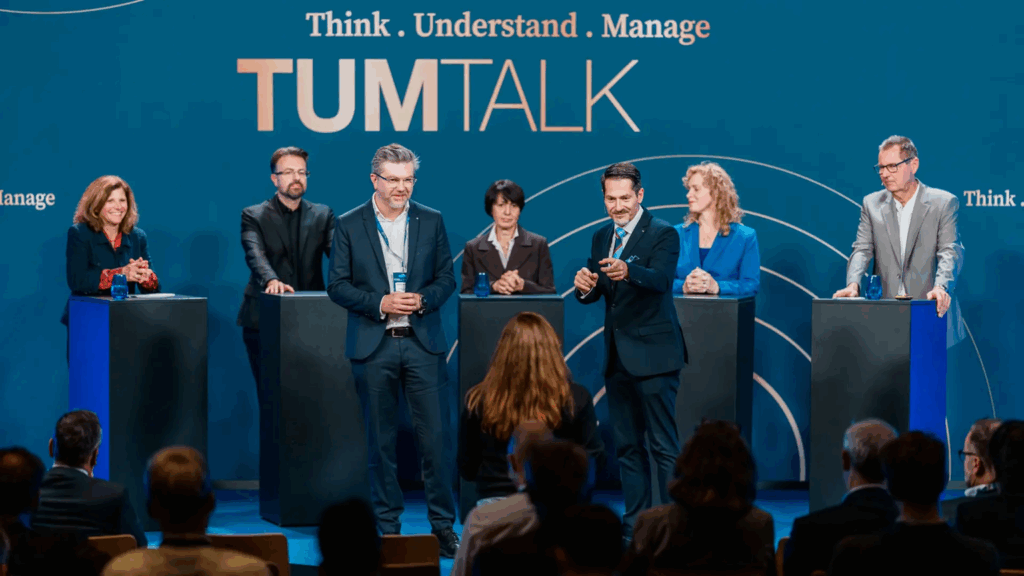
How can “innovation bridges” between science and industry be created to bring research into practice and students into companies? This question was discussed by academia and business at the sixth TUM Talk at the TUM Campus Heilbronn. The focus was on small and medium-sized enterprises.
More and more data, more and more digitalization. And yet, in the end, also the analog things have to work together for progress to happen. “Ultimately, innovation happens between people,” said Prof. Thomas F. Hofmann, President of the Technical University of Munich (TUM), at the start of the TUM Talk. This is one of the reasons why this year’s TUM Talk discussion format was entitled “Innovation Bridges for a Strong Tomorrow.” After all, this guiding principle applies in particular to the transfer of innovation between science and industry.
This was the sixth time that the university hosted the TUM Talk at its Heilbronn campus. Once again, numerous representatives from the business community accepted the invitation. Many came from the Heilbronn-Franken region, “blessed with a multitude of great companies,” as Prof. Ali Sunyaev, Vice President for the TUM Campus Heilbronn, emphasized.
The guests saw how representatives from business and science promoted change in mindsets and structures. After all, establishing resilient bridges of innovation requires a rethink on several levels, also within the companies themselves. “It is important to me that we don’t think in silos, but that we all learn from each other,” said Christine Grotz, managing partner of Weber-Hydraulik. The long-established family business is currently working on creating such new structures. In a joint venture, engineers are now also working on apps for the rescue technology sector. And in the core business of hydraulics, cybersecurity experts are now also having a say.
Family businesses meet start-ups
The more deeply traditional ways of working are established, the more difficult such a rethink can be. Yet owner-managed SMEs in particular have fundamentally good starting conditions for making changes in this area: “Smaller companies are often more open to trying new approaches,” said Dagmar Schuller. As the founder of the AI start-up Audeering and a professor at Landshut University of Applied Sciences, she has experienced what it takes to remain open to innovation: you not only need to have the technical skills, but also the right mindset.
There are plenty of challenges along the way. For example, start-ups, as carriers of innovation, face greater challenges growing in Germany than in the USA. The government and the capital sector are working to establish more opportunities, as can currently be seen, for example, in the investments in Heilbronn in the field of Artificial Intelligence. “We have to create conditions that encourage these people to stay,” said Mirko Holzer, Deputy Director at the Federal Agency for Breakthrough Innovations (SPRIND).
Sometimes, however, simple measures that even small and medium-sized enterprises can implement are enough. At the TUM Talk, Holzer encouraged the audience to give more freedom to their own purchasing departments, for example. Why not take a chance and buy from a young company that has just brought an innovation to market?
Students get to know SMEs
The discussion also made clear that universities such as TUM are a crucial piece of the puzzle on the path to resilient innovation bridges. On the one hand, they can help companies close innovation gaps in future-oriented fields such as artificial intelligence and robotics with the right basic and applied research. “This requires a strong foundation deeply rooted in the relevant scientific community,” said Prof. Hans-Joachim Bungartz, Dean of the TUM School of Computation, Information, and Technology. But it also requires “a mindset that leans toward entrepreneurial thinking.”
On the other hand, universities train the specialists and managers of tomorrow. “It is important to us that students get to know our company. And it is also important that they get to know our problems,” said Weber-Hydraulik CEO Grotz.
In order not to lose sight of economic reality amid all the scientific excellence, TUM is expanding its range of courses with a concrete practical focus. In the 1000+ project week, for example, small interdisciplinary teams of students spend a week tackling specific challenges that particularly concern small and medium-sized companies. “This kind of practical relevance has an incredibly motivating effect on students,” emphasized Bungartz, “because they can see directly what their work can achieve.”
Thanks in part to these concrete examples, the TUM Talk discussion format once again provided important impetus, which the participants then explored in depth in many lively conversations on campus following the panel discussion. TUM President Hofmann had already set the tone for many of the discussions in his welcoming address: In view of the multiple challenges currently facing the country and the economy, one could either easily despair or look ahead positively. “And I prefer the latter.”
This post was originally published on the TUM website.
Technical University of Munich
Corporate Communications Center
